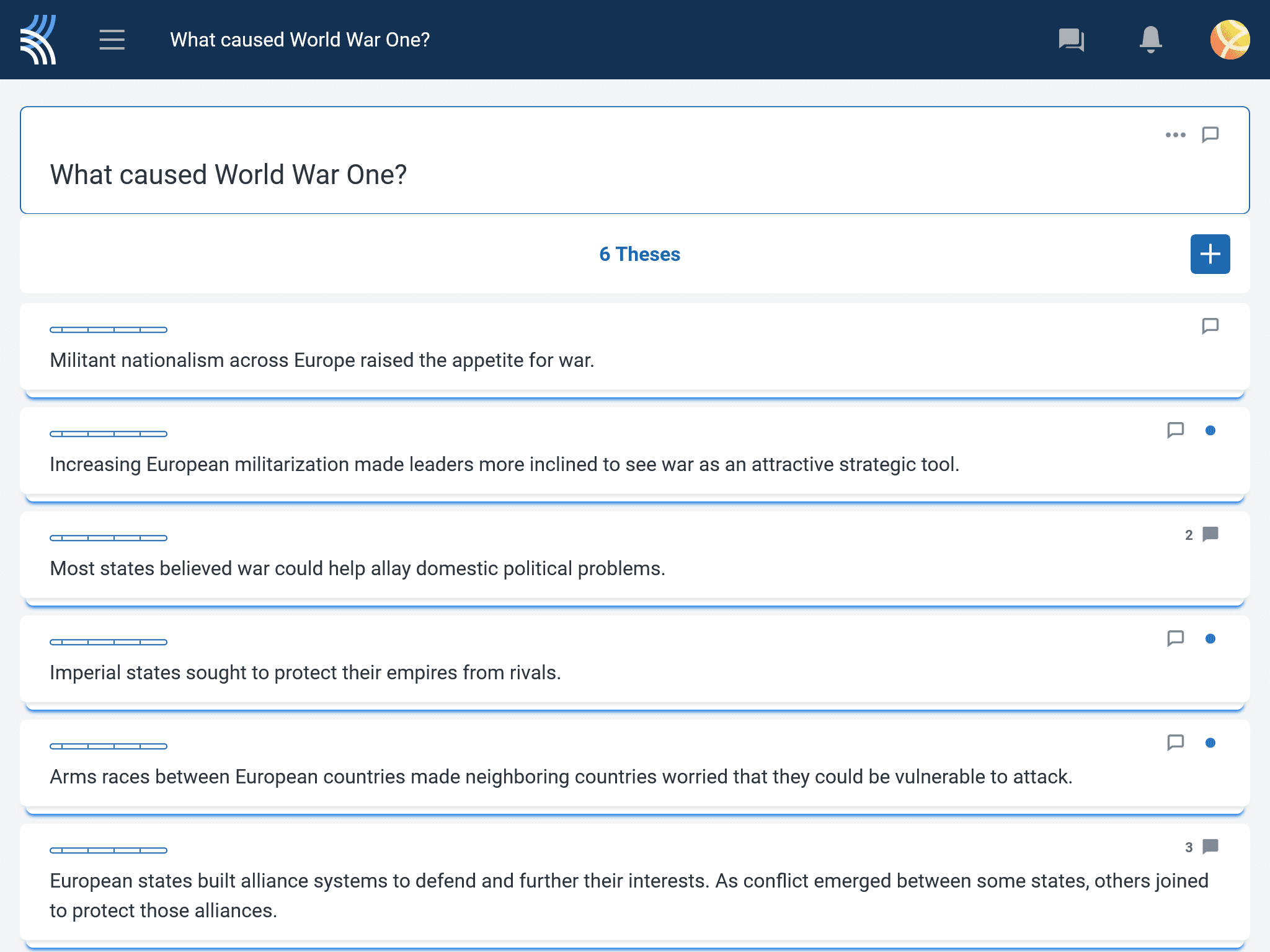When it comes to innovative approaches, the flipped classroom is all about turning conventional approaches to homework and class time on their heads.
Let’s take a closer look at what it actually means to flip your classroom, its appeal, and how you can use Kialo Edu for activities in a flipped classroom.
What is flipped learning?
As its name suggests, the flipped classroom inverts the traditional learning model to reconsider the best use of class time. Instead of using class time for direct instruction, students are introduced to new concepts at home through resources such as instructional videos, introductory activities, and texts.
Educators then use class time to deepen understanding and engage students with the new content through group activities, practical applications, or other active learning strategies.
What are the benefits of a flipped classroom?
One of the primary benefits of this approach is that students can engage with new content at their own pace to personalize a part of their own learning. This allows them to pause and rewatch lectures, look up supporting material, take meaningful detailed notes, and access dictionaries for additional language support as needed.
With flipped learning, students have time to identify points of difficulty and come to class with questions in hand. And with the foundational knowledge established at home, students are well-placed to make more complex connections during class time.
Educators can thus spend class time addressing the more challenging elements of the curriculum and helping students apply them. There can be more time dedicated to small group or one-on-one interactions, including immediate feedback and support. If using Kialo, for instance, educators can monitor from a distance, ready to step in to clear up any misconceptions, reorient the discussion, or provide feedback.
But, that’s not to say that flipped learning doesn’t have its own challenges! This model is dependent on ensuring that students do the pre-class work so they come to class ready to dive in. Preparing suitable materials which will support student learning at home can involve a significant amount of prep time for educators. Not only that, educators need to be sure that their students have access to appropriate electronic devices to use the materials that they create.
While there are many ways to ensure your flipped classroom is a success, we’ll take a look at how you can use Kialo discussions to support flipped learning with your students!
Encourage students to prepare for class by clearly outlining what they need to do at home, how they’ll use their preparation in class, and just how important it is to be prepared. You can use Kialo discussions to help students get to grips with the content before they come to class.
Importantly, students can access Kialo on mobile phones, tablets, and computers alike for exploring a discussion outside of school hours. As an extra boost to accountability, use Tasks to make expectations clear!
Share knowledge by inviting students to a discussion you have already completed with information on the learning topic. Once you’ve made your discussion, you can make a copy of the discussion and use it again for future classes!
By giving students clear instructions on how to engage with the discussion, you can give them a purpose to explore it in detail, focusing on gaining a deeper understanding. If you prefer that students not edit the discussion or interact with their classmates without real-time monitoring, set their permission to Viewer.
Here are some flipped learning activities that involve using a completed discussion to share knowledge with students.
- Task students with voting on all claims, or ask them to consider reflective questions on the overall discussion to guide their understanding.
- Ask students to add comments to the claims to note anything particularly interesting to them or points that aren’t clear.
- Ask students to explore the discussion and write quiz questions for the upcoming class.
- Have students write a short summary of their view on the thesis or theses based on their initial exploration of the topic.
- Provide each student with a copy of the discussion alongside relevant background reading or a video. Have students add sources to the claims as they do the reading to encourage them to spot the links between ideas and sources.
Flipped classroom activity #2: Have students start developing a discussion at home based on your input material
Students can use a new discussion to organize information and link it to their own existing knowledge. You might create a discussion for each student, or put them into small groups to encourage them to use this space to explore any recorded lectures, documentaries, podcasts, texts, or any other digital content you have instructed them to use.
Then, in class, have each group come together to “tidy” their discussion by identifying and resolving duplicate claims and speaking about their experience with the new content. In doing so, students engage afresh with the material within a small peer group by verbalizing their understanding in order to resolve any uncertainty.
For younger students, a good way to start building a discussion together is by giving them Suggester permissions. This gives you better control over monitoring their contributions, as you’ll have to approve claims and comments before they become visible to the wider group.
In this case, you should provide a partially developed discussion so there’s plenty to engage with. You can also set a specific time to automatically stop the discussion, and then check and approve all contributions before class starts.
Flipped classroom activity #3: Use Kialo discussions as a low-stakes way to assess student understanding of the material worked on at home
If you’re looking for an innovative way to assess students, Kialo discussions are quick to set up and easy to customize to your subject area. Start your class with a discussion to gauge understanding (and preparation!) as an engaging and supportive alternative to in-class quizzes.
The collaborative nature of a Kialo discussion means that students benefit from peer support, drawing on each other’s knowledge to remember and apply new information. Not only that, but this type of assessment also gives individual students time to reflect on the material before moving into more high-stakes activities.
Looking to save some time with grading? You can use Kialo’s built-in Grading and Feedback tool to give students grades and/or feedback, directly on their claims if you wish!
Flipped classroom activity #4: Use a Kialo discussion for students to apply their new topic knowledge to a problem or case study
Case studies require students to apply the theory they studied at home to practical situations. This active, hands-on approach can help keep students interested and involved in the material while developing real-world skills.
Start by assigning relevant case studies to small groups and give them time to identify the main issues and potential solutions. Groups can then use a multi-thesis discussion, like this one on the best method of transport in a city, to delve into the most promising solutions before coming to a final decision on how best to approach their situation. Have students present their analysis to the rest of the class, making reference to the theory to support their decisions.
Flipped classroom activity #5: Use a Kialo discussion to help students explain the topic content to a partner

When discussing a topic on Kialo, students are essentially following an argument-mapping structure to train their critical thinking skills. This visual structure makes it easy to identify connections between claims as well as flaws and gaps in reasoning.
Ask students to work in pairs or small groups to build a Kialo discussion on a shared device. Encourage them to propose and discuss each claim by adding references and sources where appropriate.
In doing so, students not only benefit from exploring their new knowledge through a clear visual structure, but they also develop topic-specific language and oral communication skills in a scaffolded format.
Flipped classroom activity #6: Use a Kialo discussion to support further research into the topic

Once students have developed a foundational knowledge of the learning topic at home, class time can be used to delve into the more challenging details, related concepts, and real-world applications.
Create new discussions for small groups, giving each group a distinct thesis related to the topic area. Task each group with carrying out further research to address their specific thesis, adding relevant claims to their discussion as they work.
Finally, ask students to present their discussion, then have the whole class vote on the thesis to share their opinions. Simply share the discussion QR code or link to give the rest of the class access to each discussion. Not only do such peer-to-peer learning strategies benefit students, but they also widen the scope of just how much can be covered in class!
Whether you choose to occasionally bring flipped learning into the classroom, or embrace it more fully, this teaching strategy offers a dynamic approach to involving students in the learning process! We’d love to hear about how you might use Kialo in your flipped class so please do get in touch on any of our social media channels or directly at feedback@kialo-edu.com!

